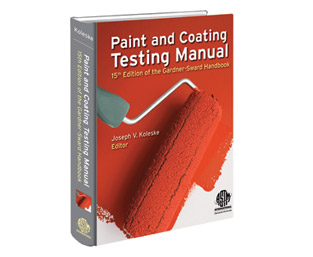
Testing Paint and Coatings
A Newly Revamped and Expanded Industry Manual from ASTM
The paint and coatings industry continues to innovate with new technology, and accompanying that is a newly updated manual for use by the industry. The work is Manual 17, Paint and Coating Testing Manual, and ASTM International has now published the 15th edition of this time-honored and respected book.
The insights in this updated and expanded edition give technologists and managers, novices and experts a useful reference about the many facets of the industry. Last published in 1995, and originally published as the Gardner-Sward Handbook, the new 15th edition provides a review of past, present and foreseeable testing trends within the scope of the sponsoring group, ASTM Committee D01 on Paint and Related Coatings, Materials and Applications.
Two chapters have been added about powder coating and radiation curing of coatings to reflect advances in these areas. As noted in the manual introduction, "Today the [powder coating] technology is well established, has a significant share of the coatings market, has an international acceptance and has a strong technical society that aids in future growth." From outdoor metal furniture to wheels, agriculture to construction materials, powder coatings have varied applications, and Manual 17 details their uses. Radiation curing, a technology that has been experiencing strong growth, converts a low viscosity liquid system into a polymeric coating on a substrate; it has enabled the development of such new products as printable electronics, medical devices and touch screens, among others. The work delves into various aspects of this technology as well.
The manual updates reflect other technological changes in several segments of the paint and coatings industry. Newly covered topics include:
- Effect pigments,
- Measurement of gonioapparent colorants,
- Surface energetics,
- Surfactants,
- Coalescing aids, and
- Understanding osmotic activity in paint films.
Overall, the manual addresses such subjects as regulations, natural and synthetic materials, plasticizers and pigments, properties and analysis.
The chapters of the new edition all come from experts in their fields, and their contributions are capable of leading to product development and problem solving, says Joseph V. Koleske, Ph.D., editor of the book. Koleske is retired from his consulting work for Consolidated Research Inc. in Charleston, W.Va., which followed his role as a corporate research fellow at Union Carbide Corp., South Charleston, W.Va., where he worked in material science and coatings. He adds that all chapters were peer reviewed by experts to ensure a high quality of information.
The manual enables readers to become familiar with diverse aspects of the paint and coatings field, whether or not those subjects are part of a paint professional's regular routine. Many ASTM standards, as well as corresponding standards of other countries, are described in the pages of the work. Manual 17 supplements information in Committee D01 standards in the Annual Book of ASTM Standards, but it does not replace them, and in many cases the material also recommends websites to check for additional information.
Koleske recommends the manual to people in the field who have questions, indicating that familiarity with it can go a long way to solving many day-to-day difficulties. "Through the years, I have found that pointing people to certain portions of the manual have both given them the solution or an approach to a problem and negated the need for calling in a consultant," Koleske says. And, as he writes in the introduction to the new edition of the manual, "readers should find the information useful and easy to read and put to use."
 SN Home
SN Home Archive
Archive Advertisers
Advertisers Masthead
Masthead RateCard
RateCard Subscribe
Subscribe Email Editor
Email Editor